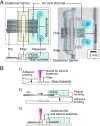Reconfigurable microfluidic device with discretized sidewall
- PMID: 28503247
- PMCID: PMC5415406
- DOI: 10.1063/1.4983148
Reconfigurable microfluidic device with discretized sidewall
Abstract
Various microfluidic features, such as traps, have been used to manipulate flows, cells, and other particles within microfluidic systems. However, these features often become undesirable in subsequent steps requiring different fluidic configurations. To meet the changing needs of various microfluidic configurations, we developed a reconfigurable microfluidic channel with movable sidewalls using mechanically discretized sidewalls of laterally aligned rectangular pins. The user can deform the channel sidewall at any time after fabrication by sliding the pins. We confirmed that the flow resistance of the straight microchannel could be reversibly adjusted in the range of 101-105 Pa s/μl by manually displacing one of the pins comprising the microchannel sidewall. The reconfigurable microchannel also made it possible to manipulate flows and cells by creating a segmented patterned culture of COS-7 cells and a coculture of human umbilical vein endothelial cells (HUVECs) and human lung fibroblasts (hLFs) inside the microchannel. The reconfigurable microfluidic device successfully maintained a culture of COS-7 cells in a log phase throughout the entire period of 216 h. Furthermore, we performed a migration assay of cocultured HUVEC and hLF spheroids within one microchannel and observed their migration toward each other.
Figures







Similar articles
-
Reconfigurable Microfluidic Channel with Pin-discretized Sidewalls.J Vis Exp. 2018 Apr 12;(134):57230. doi: 10.3791/57230. J Vis Exp. 2018. PMID: 29708554 Free PMC article.
-
A cell electrofusion microfluidic chip using discrete coplanar vertical sidewall microelectrodes.Electrophoresis. 2012 Jul;33(13):1980-6. doi: 10.1002/elps.201100579. Electrophoresis. 2012. PMID: 22806463
-
Dual frequency dielectrophoresis with interdigitated sidewall electrodes for microfluidic flow-through separation of beads and cells.Electrophoresis. 2009 Mar;30(5):782-91. doi: 10.1002/elps.200800637. Electrophoresis. 2009. PMID: 19197906
-
Rollable Microfluidic Systems with Microscale Bending Radius and Tuning of Device Function with Reconfigurable 3D Channel Geometry.ACS Appl Mater Interfaces. 2017 Mar 29;9(12):11156-11166. doi: 10.1021/acsami.7b00741. Epub 2017 Mar 20. ACS Appl Mater Interfaces. 2017. PMID: 28267308
-
Sheathless hydrophoretic particle focusing in a microchannel with exponentially increasing obstacle arrays.Anal Chem. 2008 Apr 15;80(8):3035-9. doi: 10.1021/ac8001319. Epub 2008 Mar 21. Anal Chem. 2008. PMID: 18355090
Cited by
-
Reconfigurable Microfluidic Channel with Pin-discretized Sidewalls.J Vis Exp. 2018 Apr 12;(134):57230. doi: 10.3791/57230. J Vis Exp. 2018. PMID: 29708554 Free PMC article.
References
LinkOut - more resources
Full Text Sources
Other Literature Sources
